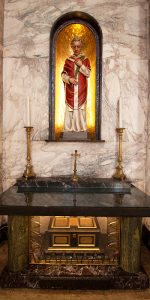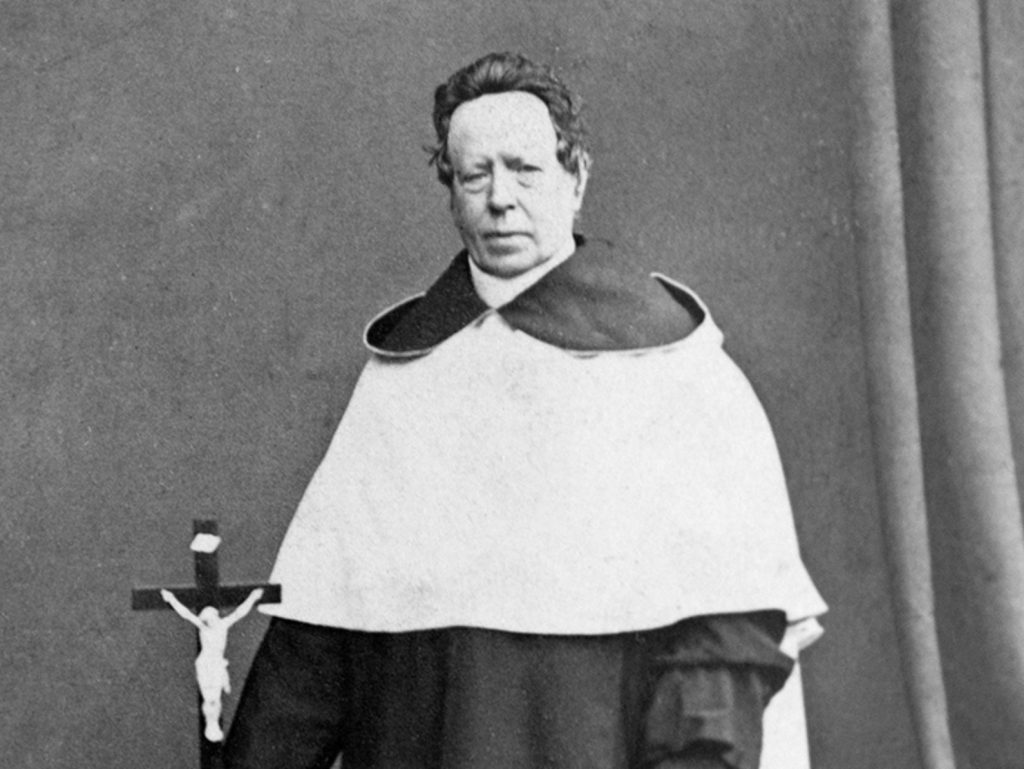A Carmelite priest was gifted the relics of Saint Valentine, now enshrined in Our Lady of Mount St.Carmel, Whitefriar Street Church, Dublin.
He will be forever linked with St. Valentine, but John Francis Spratt would be remembered as a beloved philanthropist, famous for his work among the poor and destitute in the Liberties of Dublin. He was one of the first to join Fr. Matthew’s temperance movement in Ireland. Until his death, he worked tirelessly for the cause of total abstinence, on-call at any time to administer “the pledge.”
In addition to the building of Dublin’s Whitefriar St. church, Our Lady of Mount St. Carmel, in 1826, Spratt also founded St Peter’s Orphanage; St Joseph’s Night Refuge Cork Street for the homeless poor; the Asylum for the Catholic Female Blind at Portobello, and the schools on Whitefriar Street, Dublin.
John Francis was born January 1796 in Cork St., Dublin, son of James Spratt and Elizabeth Spratt (née Bollard). He was baptized (January 5, 1796) in St. Catherine’s Church, on Meath Street.
He attended Dolphin’s Barn National School in Dublin and went to Spain (August 1816) as an aspirant in the Carmelite order. He was received into the order in December 1816, he completed his novitiate as a member of the Carmelite province of Castille and was ordained (26 February 1820) by Petrus Antonius de Trevilla, bishop of Cordova. His brother, James, later became an Augustinian friar.
After further theological studies at Seville, John Francis returned to Dublin (1822) and joined the community of Calced Carmelites in Cuffe Lane, off French St., and set about establishing a school on Longford Street. He also acquired a site in Whitefriar Street and it was largely due to his exertions that the Carmelite church, Our Lady of Mount Carmel’s, was built there. Building work was completed in 1826 to a design of George Papworth, and the church was consecrated in 1827.

Appointed as the church’s first prior, John Francis visited Rome in 1835, and it was due to his efforts, and to reward him for his good works, that Pope Gregory XVI agreed to send the remains of Saint Valentine to Our Lady of Mount Carmel. The saint had been buried in the cemetery of Saint Hippolitus, but his remains were disinterred and arrived in Dublin on 10 November 1836, being placed under the altar of the church.
Spratt also acquired in a local antique shop a wooden statue of the Virgin, which later proved to be of late medieval origin. It is believed that this statue came from Saint Mary’s Abbey and was the one from which the crown was taken to crown the pretender Lambert Simnel in 1487.
Both of these features made the church on Whitefriar Street, the focus of popular pilgrimages in Ireland. Each year on Valentine’s Day, the remains are moved to the main altar for a special Mass.
St. Valentine aside, Spratt is best remembered for his philanthropic work in Dublin. He founded various charitable institutions such as St Peter’s orphanage and the free schools on Whitefriar Street.
He served as commissioner general of the Carmelite order in England (1838–44).
During the famine he organized an interdenominational relief committee and was appointed (May 1849) secretary of the Royal Exchange or General Relief Committee. He was also active politically, and had been involved in both the emancipation and repeal campaigns.
Engaged in the campaign to prevent the transportation of William Smith O’Brien, leader of the Young Ireland movement, in 1849, he was also profoundly interested in the plight of tenant farmers, and attended the tenant-right conference held in Dublin in August 1850.
In 1860 Spratt founded the Catholic Asylum for the Female Blind and rented Portobello House as the charity’s premises. Run by the Sisters of Charity, the institution was moved to Merrion Gates in 1868. In 1861 he rented Stove Tenter House off Cork Street and founded St Joseph’s Night Refuge for women and children.
Appointed provincial of the Carmelite order in Ireland (1863), he became increasingly involved in the temperance movement and was an associate of Fr. Theobald Mathew and James Haughton.
He founded the French St. Temperance Society, but in 1871 began to suffer from ill-health. Doctors diagnosed circulation problems and recommended that he take alcohol, but he refused to do so.
On 27 May 1871, while administering the total abstinence pledge to those willing to pledge an alcohol free life, he died of a sudden heart attack at Mount St. Carmel church. He was buried in Glasnevin cemetery, near the tomb of Daniel O’Connell, the Irish patriot.
Note: In recent years, the question of whether the relics can be accurately attributed to St. Valentine has been raised, with churches in Rome, Terni, and Glasgow also claiming to have the remains of St. Valentine enshrined. But Ireland’s claim is the only one certified by a pope.
The reliquary arrived in Dublin on November 10, 1836, in a wooden casket with Pope Gregory XVI’s coat of arms, accompanied by a letter attesting to the contents of the casket. The translation from Latin below is available on the website of the Carmelites of Ireland:
“We, Charles, by the divine mercy, Bishop of Sabina of the Holy Roman Church, Cardinal Odescalchi Arch Priest of the Sacred Liberian Basilica, Vicar General of our most Holy Father the Pope and Judge in Ordinary of the Roman Curia and of its Districts, etc, etc.
To all and everyone who shall inspect these our present letters, we certify and attest, that for the greater glory of the omnipotent God and veneration of his saints, we have freely given to the Very Reverend Father Spratt, Master of Sacred Theology of the Order of Calced Carmelites of the convent of that Order at Dublin, in Ireland, the blessed body of St. Valentine, martyr, which we ourselves by the command of the most Holy Father Pope Gregory XVI on the 27th day of December 1835, have taken out of the cemetery of St Hippolytus in the Tiburtine Way, together with a small vessel tinged with his blood and have deposited them in a wooden case covered with painted paper, well closed, tied with a red silk ribbon and sealed with our seals and we have so delivered and consigned to him, and we have granted unto him power in the Lord, to the end that he may retain to himself, give to others, transmit beyond the city (Rome) and in any church, oratory or chapel, to expose and place the said blessed holy body for the public veneration of the faithful without, however, an Office and Mass, conformably to the decree of the Sacred Congregation of Rites, promulgated on the 11th day of August 1691.
In testimony whereof, these letters, testimonial subscribed with our hand, and sealed with our seal, we have directed to be expedited by the undersigned keeper of sacred relics.
Rome, from our Palace, the 29th day of the month of January 1836.
C.Cardinal Vicar
Regd. Tom 3. Page 291
Philip Ludovici Pro-Custos”
Spratt published several theological and devotional works during his career, including The Real Presence of the Body and Blood of Our Lord Jesus Christ in the Holy Eucharist etc. (1850) and Eulogium of the Blessed Virgin (1868). ♦
Sources for this article which was published in the Dictionary of Irish Biography: William J. Battersby, Authentic life of Dr Spratt (1871); Webb; Boase; Ir. Monthly, xv (Dec. 1887), 706–7; R. J. O’Duffy, Historic graves in Glasnevin cemetery (1915), 65–6; Peter O’Dwyer, Fr John Spratt, beloved of Dublin’s poor: a centenary tribute (1971); Colm Kerrigan, Fr Mathew and the Irish temperance movement, 1838–1849 (1992); Donal Kerr, ‘A nation of beggars?’: priests, people and politics in famine Ireland, 1846–1852 (1994)
Publishing information: DOI:https://doi.org/10.3318/dib.008212.v1
Originally published October 2009 as part of the Dictionary of Irish Biography
Last revised October 2009This content is licensed under a Creative Commons Attribution Non Commercial 4.0 International license.


Leave a Reply